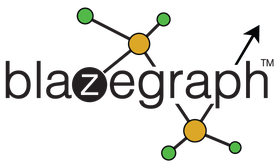Blazegraph
Acquired Company
Blazegraph is an open-source graph database system written in Java. Blazegraph is supported for use on a standalone server, as well as a highly available (HA) replication cluster. ACID properties are fully supported in both use cases. Blazegraph makes use of multi-version concurrency control (MVCC). As a graph database, Blazegraph is optimal for storing and querying linked data. Blazegraph uses RDF and RDR as the standards for the data model.
History
Blazegraph, formerly known as Bigdata, was released in August of 2016. Its former version, Bigdata, was released in February of 2015. Blazegraph was announced as SYSTAP, LLC's flagship product. Blazegraph is still supported as of December 2018. Blazegraph was developed to work with web-scale semantic graphs. Blazegraph's key-range partitioned B+ tree indexing was influenced by the architecture of Google's BigTable system. SYSTAP, LLC received funding from DARPA to develop the GPU-acceleration feature of Blazegraph. Blazegraph has been used as part of commercial applications in addition to being resold by various OEM companies.
Amazon acquired Blazegraph in 2018 and the open-source project was abandoned.
Checkpoints
Blazegraph supports consistent checkpoints and is capable of providing a consistent database state given a user-specified commit point. During checkpoint operations, Blazegraph codes records into binary format before writing them onto disk. Blazegraph also supports group commits during checkpoint operations.
Concurrency Control
Optimistic Concurrency Control (OCC)
Blazegraph supports transactions. Blazegraph uses Multi-Version Optimistic Concurrency Control (OCC).
Data Model
Blazegraph functions as a triplestore (RDF) and graph database. As a graph database, Blazegraph uses a graph structure of nodes and edges to represent data. Blazegraph also supports the triplestore (RDF) data model, which can be viewed as a specialized version of graph databases that is optimized for storing and retrieving triples. The advantage of RDF is that it provides a standardized data model that support data merging between differing schemas.
Indexes
Blazegraph uses key-range partitioned B+ tree indices as part of its architecture. Keys and values are both implemented as byte arrays. Each index is a tuple consisting of the key, value, a "deleted" flag, and a revision timestamp. The "deleted" flag signifies whether or not the item has been deleted and thus should be considered historical data. Blazegraph uses read-optimized, read-only B+ tree files for each key-range partition to support faster doubly-linked navigation between sibling leaves in the tree.
Joins
Hash Join Index Nested Loop Join
Blazegraph supports both nested index joins and hash joins. For RDF databases, the access path for nested index joins are pre-existing. Hash joins are built dynamically during query evaluation. Blazegraph supports hash join operators that run on JVM heap, as well as hash join operators that use the native process heap and memory manager. The former is more appropriate for lower volumes of data, while the latter is more appropriate for higher volumes. The latter type of hash joins is superior for higher volumes of data because it can support as much data as available RAM. The latter also does not result in overhead issues with the JVM garbage collector, while the former may.
Query Compilation
Stored procedure compilation is supported in Blazegraph through the SPARQL extensions. A stored query can take the form of a parameterized SPARQL query or simply contain procedural application logic. With Blazegraph, stored queries are advantageous because they allow for application logic to be carried out on a server without having to marshal data across the HTTP interface.
Storage Model
Blazegraph uses a hybrid storage model design. Blazegraph uses a row store approach but also gives consideration to column family. Inspired by Google BigTable, Blazegraph restricts concurrency control to ACID operations on items that share both row and column family. This is done to facilitate the use of a local locking scheme.
Storage Organization
Blazegraph makes use of copy-on-write mechanisms for index updates on its B+ tree. With unisolated operations, writes are done on the index objects. The indices are checkpointed once the transaction commits; otherwise, the write set is discarded. However, with isolated operations, writes are done with a copy-on-write approach. The transaction can commit as long as there are no write conflicts.
Website
Source Code
https://github.com/blazegraph/database
Developer
SYSTAP, LLC.
Country of Origin
Start Year
2006
End Year
2022
Former Name
Bigdata
Acquired By
Amazon
Project Type
Written in
Supported languages
C, C++, Java, JavaScript, PHP, Python, Ruby




